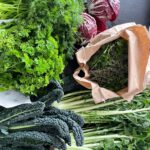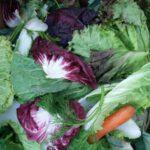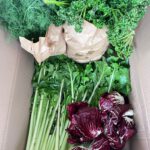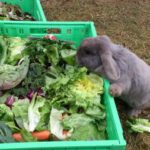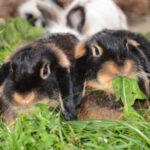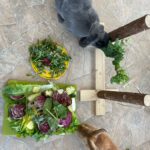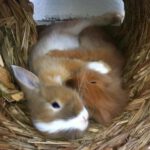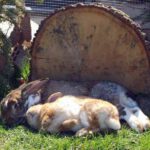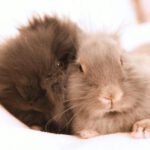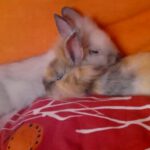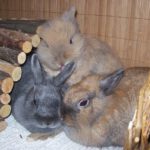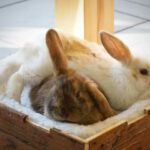Contents
- Pellets, Mixed Feed, and Rabbit Food
- Secondary Diseases from Feeding Dry Food
- What is dry food made of?
- Texture & Structure Are Crucial
- Swelling test with rabbit pellets
- What additives are included in the food?
- Nutritional Additives
- Additives for Flavor
- Are Additives Harmful?
- The Myth of Healthy „Grain-Free Dry Food“
- Which dry food can I safely feed my rabbit?
Pellets, Mixed Feed, and Rabbit Food
Various types of „complete feed“ and mixed feed for rabbits are available in stores. Manufacturers promote these products with claims of extra vitamins and nutrient richness on the colorful packaging.

Secondary Diseases from Feeding Dry Food
The list of secondary diseases that are promoted and triggered by a diet of dry food is extensive.
Dental Diseases:
Only 20% of dental issues can be seen with a careful examination of the mouth; the remaining 80% can only be detected through an oral examination under anesthesia and multiple X-rays of the head from different angles, followed by a detailed evaluation.
Root diseases are a common consequence of a dry food diet and, in advanced stages, may present symptoms such as watery eyes, abscesses, or nasal discharge (often misdiagnosed as a respiratory infection by veterinarians not experienced with rabbits). Food intolerances, especially to large amounts of fresh food or fresh foods in general, are a typical sign of dental problems.
Dry food makes rabbits feel full more quickly, with even small amounts (like a tablespoon a day) causing them to eat less than half of the required amount of fresh greens. This lack of sufficient chewing prevents the necessary wear on their continuously growing teeth. Due to the fine texture of dry food (milled meal instead of fibers), it is barely chewed. Additionally, rabbits chew dry food differently than their natural diet: dry food is „cracked“ (which places excessive strain on the jaw and tooth roots, leading to retrograde tooth growth), while fresh greens are ground down.
To address these issues, affected teeth must be filed under anesthesia by a rabbit-savvy dental veterinarian, and the rabbit’s diet needs to be adjusted accordingly.
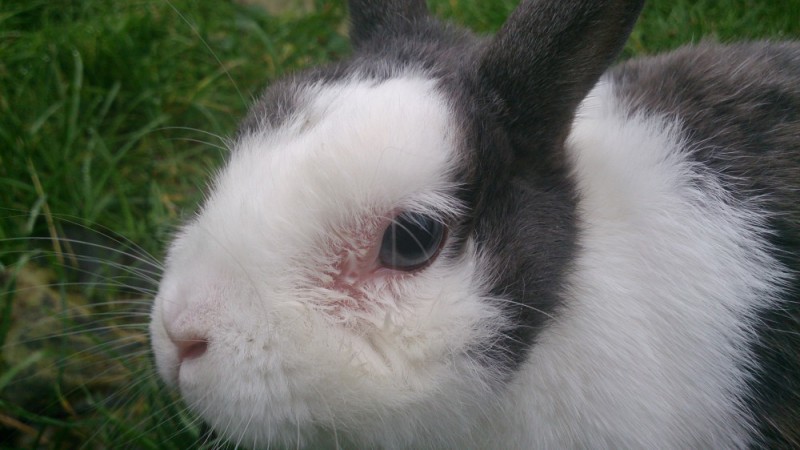
Digestive Disorders:
Many animals eventually develop diarrhea from fresh food or can no longer tolerate certain foods! Even „occasional diarrhea“ or an overproduction of cecotropes is a common consequence of dry food. Some animals are prone to constipation, bloating, and gastric dilatation. There are several reasons for this: Firstly, rabbits need very coarse, fibrous food due to their poorly developed peristalsis, which helps transport food through their intestines more effectively. Dry foods are finely ground and consist of feed meals, which slow down the metabolism. Secondly, rabbits have a very specific bacterial flora in their digestive tract. Feeding dry food nourishes harmful bacteria, which then spread and overwhelm the healthy gut flora.
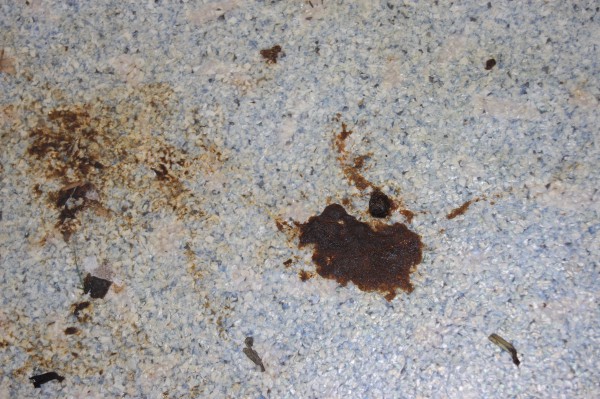
Bladder gravel, bladder stones, kidney stones, and more:
Feeding dry food results in significantly less consumption of fresh greens. Even less than a tablespoon per day per animal reduces the fresh food intake so drastically that they consume less than half as much green food. The lack of water in the diet cannot be compensated by drinking; there are extensive studies on this! The urinary tract is insufficiently flushed. Rabbits do not absorb calcium according to their needs, but rather in the amount they take in: Due to their unique calcium metabolism, less water intake quickly leads to deposits in the kidneys or bladder, as the urine becomes more concentrated. Additionally, artificially added vitamin D in dry food can trigger deposits in the urinary tract.
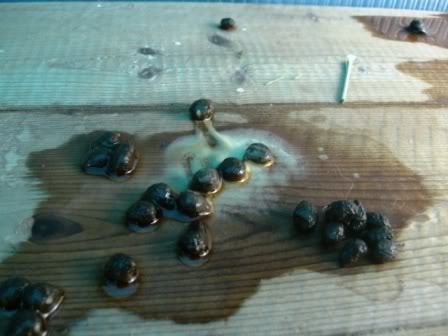
Overweight/underweight and associated health issues:
The energy content of these foods is also very high, which can lead to obesity and organ damage (often accompanied by weight loss). As a result, joint problems can occur (excess weight puts pressure on the bones), digestive issues (organs are displaced by fat), and bladder gravel (the animals move less, making it easier for deposits to form). Rabbits fed dry food become much quieter and „lazier,“ and this has various causes. On one hand, the food strains digestion because it is completely unnatural and unsuitable, making it heavy on the stomach. On the other hand, the metabolism is altered. Dry feeding triggers a dry metabolism, causing the animals to conserve energy and become very calm. Due to the high energy density, the animals quickly feel full, so they neither need to work for their food nor are they engaged in searching for or consuming it.
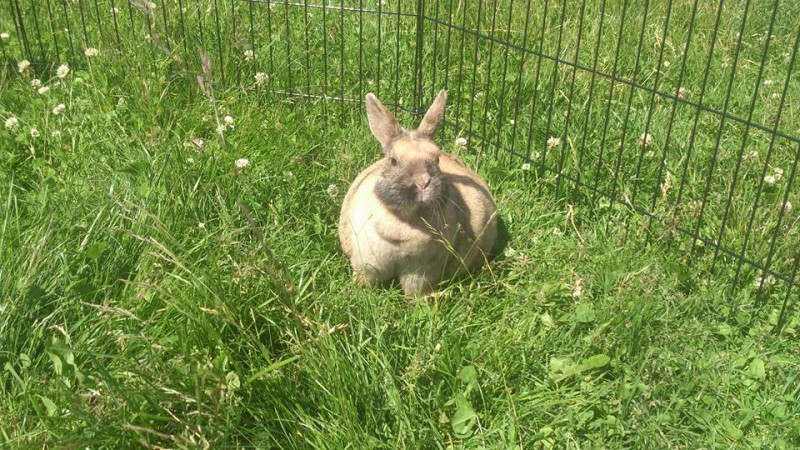
Behavioral issues:
Due to the higher energy content, the rabbits quickly feel full, so they spend only one-tenth of the time eating. A freshly fed animal typically spends 80% of its active phases eating. As a result, various behavioral problems arise from boredom, such as chewing on bars, pulling out fur, or licking wounds.
For many years, it has been known among veterinarians that commercially available rabbit food causes health problems. A two-year study at the University of Edinburgh in Scotland scientifically investigated the effects of feeding rabbits muesli. The results can be seen in this poster:
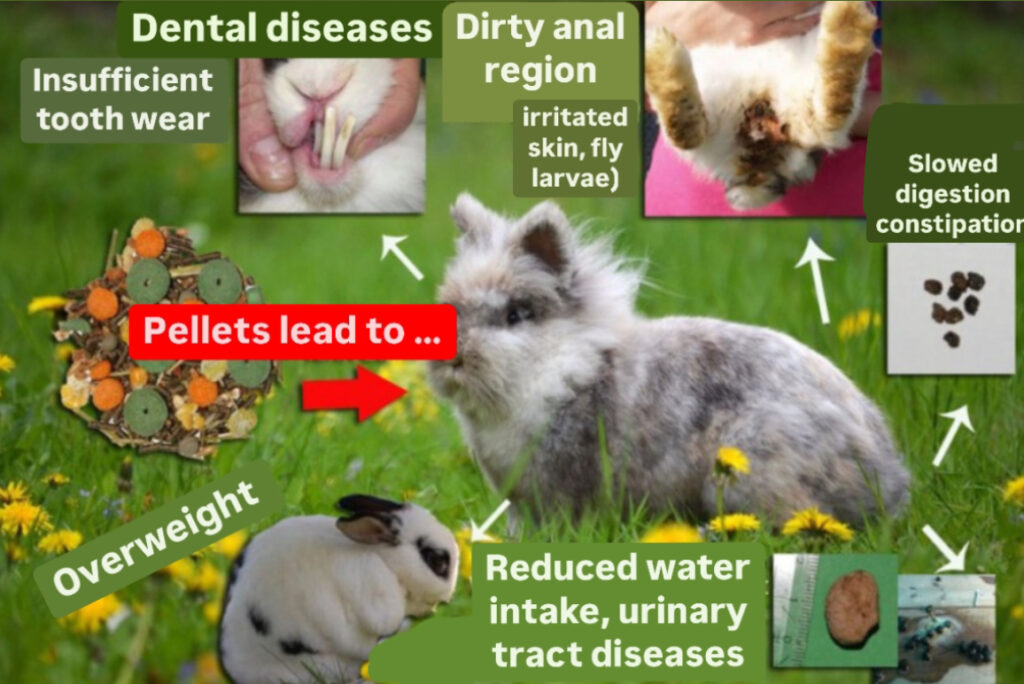
As a result, some manufacturers and pet store chains have decided to completely remove mixed rabbit food from their product lines.
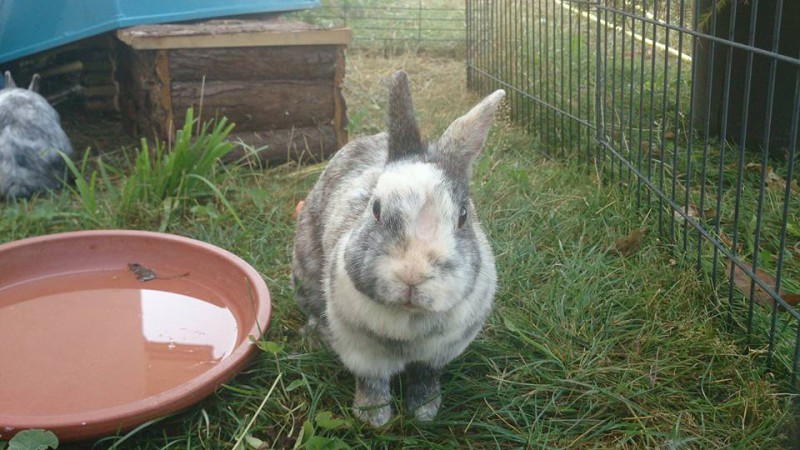

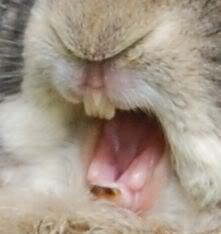
Black Tooth Tips
Before (feeding with grain-free dry food) – After (dry food-free feeding)
What is dry food made of?
Rabbit food – what’s inside?
The composition of most rabbit food mixes can be found on the back of the packaging, in small print under „Ingredients.“ However, some types of food do not list the ingredients, and such foods should generally be avoided. According to current laws, ingredients can be used in food that are not listed, so even a declaration does not guarantee safety.
Additionally, the composition of foods with labels is not always clear. Typically, only food groups are listed, which can consist of very different components.
- „Vegetable by-products“ can be any plant material considered waste in the industry. For a period, even „poultry droppings“ were allowed to be added as (animal) „by-products,“ but this is now prohibited.
- The ingredient „grain“ does not specify which type of grain it is (corn, rye, spelt, wheat, oats, etc.) or in what form it is included. The same applies to „seeds“ as an ingredient.
- „Egg products“ are waste by-products from egg processing and are just as unhealthy as „milk and dairy products.“ Both do not belong to a rabbit’s natural diet and are harmful to health.
- The term „vegetables“ includes all vegetables (even processed) and legumes. „Fruits“ refers to all types of fruit, including processed forms.
- The term „sugar“ covers all types of sugars, while „oils and fats“ can be plant-based or animal-based oils/fats of any kind.
The main component of most commercial mixes is cheap filler material, essentially a cost-effective mass often made from industrial waste (labeled as „vegetable by-products,“ „animal by-products,“ pomace, wheat bran, gluten, etc.) or components that are inexpensive on the global market (e.g., grains).
Since fillers are chosen based on price (as cheaply as possible) rather than their nutritional value and suitability for rabbits, this composition is entirely wrong. Rabbits are folivores (leaf tips and herb eaters) and therefore require a herb-rich, fresh diet. The composition of commercial mixes does not meet this need. Additionally, the ingredients are not selected based on their natural value (e.g., vitamin and mineral content), resulting in an unfavorable nutrient balance that is intended to be „corrected“ with artificial vitamin and mineral supplements.
Commercial mixed feeds are generally too high in energy for most rabbits, which can lead to obesity, fatty organ deposits (sudden death, one of the most common causes of death in rabbits), and lethargy in rabbits that only require maintenance (e.g., animals that do not perform special tasks, or those not living in outdoor winter conditions).
The high starch and sugar content of this unnatural food leads to an overgrowth of yeast in the gut flora.
The pet food industry attempts to sell cheap ingredients to consumers at high prices through commercial mixed feeds.
Texture & Structure Are Crucial
The ingredients of the food are processed by first being ground down. During this grinding process, the components lose all their natural structure.
Only structured food leads to adequate tooth wear, as it requires prolonged chewing. If the food is already ground up, the rabbit swallows it after just a few chewing motions, and the necessary tooth abrasion is not achieved. Moreover, the unnatural chewing movement (crushing pellets and extrudates instead of uniform grinding motions) increases pressure on the tooth roots, potentially causing retrograde tooth growth. This means the tooth roots move into the jaw and may even break through. This leads to pain and jaw abscesses. Since the tear duct runs near the tooth roots, watery eyes are a common side effect.
Due to grinding, the individual particles are usually smaller than 0.3 mm, which, as studies have shown, can cause digestive issues. Rabbits need a certain structure in their food. Highly ground components are processed in the rabbit’s cecum, and this can result in an excessive amount of cecal droppings, cecal inflammation, or constipation. Additionally, digestion relies on sufficient structure to help move the food through the digestive system, and a lack of this structure can lead to constipation or diarrhea.
The fine grinding and processing (heating) of the mash makes it swell when it comes into contact with liquid. Natural food doesn’t swell when it meets liquids like stomach acid or water, but dry food can increase its volume up to five times! This puts significant strain on the delicate, thin stomach walls, which is very painful for the rabbit.
After the ingredients are ground, they are mixed, heated, and shaped using dies or other forming machines. The heating process destroys vitamins and other nutrients, leaving behind a mash made from waste products with no nutritional value.

Swelling test with rabbit pellets
- They easily expand to five times their original size and absorb large amounts of liquid.

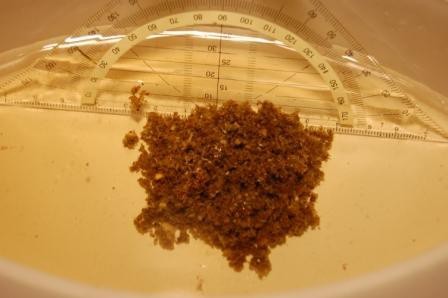
What additives are included in the food?
Some ingredients do not necessarily have to be listed on the packaging in Germany.
„In pet food within the EU, ingredients such as appetite stimulants, emulsifiers, acid regulators, stabilizers, thickeners, etc., do not have to be separately declared. The German Animal Welfare Association is therefore calling for mandatory labeling for pet food as well. ‚Pet food should be about balance, not overfeeding,‘ said Roman Kolar from the German Animal Welfare Association…“
Source: http://dgk.de
Legal Framework: Which additives do not have to be labeled?
The „Guideline for the Labeling of Single and Mixed Animal Feeds“ from the Federal Ministry of Food and Agriculture provides a clear overview of which additives do not need to be declared. Among the additives that do not need to be listed are:
- Additives that are part of a preparation of an approved additive (e.g., antioxidants, binders)
- All additives for which no maximum content is legally required, and which do not fall under the categories of „zootechnical additives,“ „coccidiostats and histomonostats,“ „additives from the functional group ‚urea and its derivatives‘,“ or „nutritional additives“ as defined in Annex I of Regulation (EC) No. 1831/2003 (Regulation (EC) No. 767/2009, Annex VI).
- Additives from the functional groups „preservatives,“ „antioxidants,“ and „colorants“ only need to be listed under a general heading.
- Flavorings from premixes only need to be labeled as „mixture of flavorings.“
- Additives from individual ingredients, which are mixed into compound feeds (e.g., preservatives, antioxidants, flow agents), do not need to be listed in the compound feed (Article 15, letter f in conjunction with Annex VI and VII). However, in such cases, it is not allowed to advertise the absence of these additives (e.g., „no preservatives,“ „no antioxidants“) (Article 11, paragraph 1, letter a in conjunction with Article 13, paragraph 1).
Nutritional Additives
To make the highly processed (and thus vitamin-deficient) mash suitable as feed, several essential substances are added before the pressing process.
Synthetic vitamins and provitamins are included (re-vitaminization), but these artificial substances are not equivalent to their natural counterparts and are often extremely overdosed in almost all feeds, which can lead to organ damage.
To correct the imbalanced amino acid profile of the waste ingredients, amino acids are added.
In common rabbit feeds used in German households, there is an excess of minerals. Nevertheless, some mixed feeds still have additional minerals and trace elements added. This surplus can lead to bladder and kidney diseases (bladder stones, kidney stones, deposits, kidney failure, urinary grit, bladder sludge, etc.).
Probiotics are sometimes added to maintain gut health, which is negatively impacted by the unnatural food.
To assist in the digestion of food components that the natural gut flora cannot break down, many dry foods are supplemented with enzymes.
Additives for the Human Eye
Colorants are used to dye extrudates and pellets in appealing colors because the industrial mash, which is mainly made from waste products, looks unappetizing and brown without color additives. Green-colored ingredients are intended to imitate herbs, yellow-colored ingredients represent grains, and red ones are meant to symbolize fruits. This trick seems to work, as many rabbit owners still believe that the pellets in mixed feed are made of herbs or hay.
To prevent the individual components from clumping together, anti-caking agents are used.
Antioxidants, packaging gases, and preservatives are employed by feed producers to extend the shelf life of the food.
To bind ingredients that do not naturally mix (e.g., oils with water), emulsifiers are used.
Additives for Flavor
Artificial flavors are added to rabbit food to stimulate appetite, which artificially increases food intake, often leading to obesity. While this is desirable in farm animals for rapid weight gain, it becomes an undesirable side effect in pets.
The feed industry adds artificial flavorings because most pet owners buy the food that their animals prefer and eat the most. Pet owners enjoy watching their animals eagerly devour their food. Numerous studies have shown that flavors significantly increase appetite, leading to better acceptance by animals. Most rabbits eat the food (which is made from low-quality ingredients) only because the artificial flavors influence their food selection. Artificial flavors and flavor enhancers make rabbits addicted.
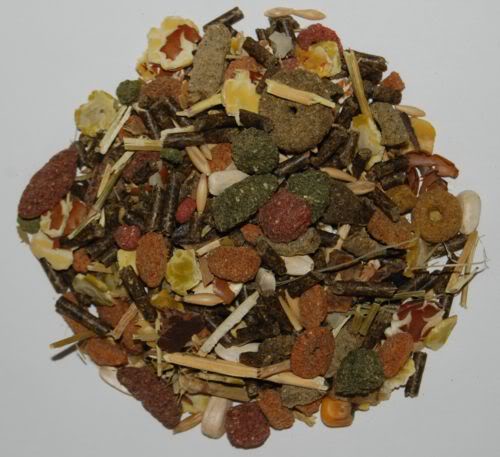
Are Additives Harmful?
Some additives have been found to be contributing factors in a variety of diseases, such as allergies, asthma, cancer, and more. Other additives are considered to be relatively harmless.
Vitaminized Structured Feed – Is Such Feed Useful?
Advantages:
- It contains structured components and not extrudates, pellets, or other ground ingredients like many other feed types. As a result, its composition is of higher quality compared to other rabbit feeds, and it doesn’t have the drawbacks of many other dry foods.
- As an energy feed for outdoor housing (winter, large breeds), it may be suitable in certain cases.
- The added synthetic vitamins help prevent deficiency diseases if the vitamin supply is not adequately covered by other feeding or housing practices.
- Affordable price and easy handling.
Disadvantages:
- The feed consists of about 50% grains and other energy-rich components (e.g., carob), making it an energy feed that is unsuitable for indoor housing of small breeds, and it may lead to issues like tooth spurs, etc.
- The herb content includes only two herbs and mainly de-leafed alfalfa, so the variety of herbs is quite limited.
- The included carob and similar ingredients can harm the teeth and promote retrograde tooth growth.
- The synthetic vitamins added can negatively affect health (particularly organ damage) and do not function the same way as natural vitamins. As such, they are not a complete substitute for natural vitamins and plant substances. This requires a balanced basic diet, which would already cover the vitamin supply, making the vitamin additives unnecessary.
Conclusion:
As a sole food (as indicated on the packaging), this feed is definitely not suitable. It also can never replace a healthy, balanced diet that provides the rabbit not only with vitamins and minerals but also with plant compounds.
A diet deficient in Vitamin A or Vitamin E, or housing conditions that prevent the rabbit from having direct sunlight or access to a UV-B lamp (for Vitamin D synthesis), can be partially improved by this feed, although the rabbit will still be lacking many other essential nutrients.
However, with a balanced, adequate diet, this feed is unnecessary, and the synthetic vitamins it contains should be viewed with caution, as they can harm the rabbit’s health. The high energy content leads to obesity in many rabbits (and its related health complications). Additionally, this feed has been shown to damage the teeth and can lead to dental issues.
The Myth of Healthy „Grain-Free Dry Food“
The myth persists that grains are the cause of many health problems that can be triggered by dry food. In fact, grain is initially quite a natural food source. Wild rabbits consume some grain in the summer, autumn, and early winter by eating the grain heads. In this form, grain is very well tolerated and is a good energy food or supplement to the diet. However, there are certain cases where grain can actually be intolerable or harmful:
- When wheat or rye is fed. These types are poorly tolerated, so it is better to opt for other grains.
- When grain becomes the main food. Grain should always be a small supplement, not the primary food source.
- When the grain is offered incorrectly (e.g., as loose kernels). It must always be fed with the husk (grain heads or grains with husk!).
- When it is heavily processed (e.g., ground or pressed for dry food), which removes the important structure.
- When grain is regularly offered in indoor housing (or to rabbits with low energy requirements).
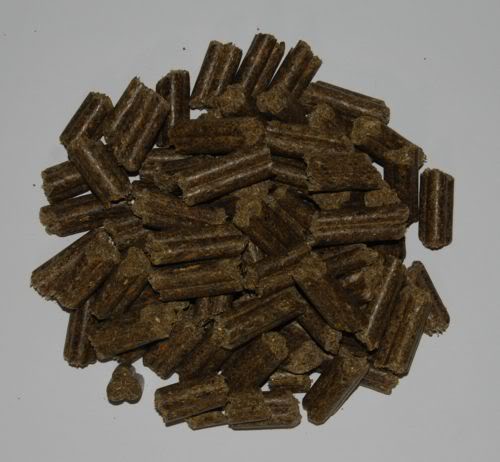
For example, seasonal (autumn) grain heads can be offered to rabbits, provided their main diet consists of meadow herbs, leafy vegetables, herbs, and other species-appropriate food: Seed and Grain Feeding
Most commercial dry foods that advertise „grain-free“ (e.g., Bunny Rabbit Food (Grüner Traum, etc.), Vitakraft Emotion Sensitive, QP3 Rabbit Food, Mucki Aktiv & Fit, etc.) are aimed at pet owners who avoid grains, believing them to be unhealthy. However, these foods often still contain grain components like wheat bran. Even many veterinarians preach against the harm of grains, yet still promote these relatively expensive grain-containing foods. In dry food, grain is usually one of the smaller issues. Major problems typically arise from the composition, structure/processing, and additives (as mentioned above). The only advantage some, though not all, grain-free dry foods may offer is a slightly lower energy content.
Which dry food can I safely feed my rabbit?
If you want to feed your rabbit healthily, you should avoid dry food. It can lead to the health issues mentioned above! There are some dry foods that may be suitable as energy food or a supplement in certain specialized cases. However, their use should be carefully considered to avoid health problems.
Quotes on the topic:
„Obesity is a major and widespread problem in our pet rabbits. The cause is that they are often fed too much of the wrong food and get too little exercise. Commercial pellets and colorful mixed feeds are low in fiber and have too high an energy content and nutritional value. The grains are not bitten off but merely crushed with the molars, so the constantly growing teeth are insufficiently worn down due to the lack of grinding movements. Oversized teeth that injure the tongue or cheek mucosa are the result. Colorful feeds also lead to an imbalanced diet because the ‚delicious‘ sugar- and starch-rich parts are preferentially consumed, while the rest is left behind. This disrupts digestion and leads to vitamin deficiencies, among other things. Even snacks like milk and yogurt drops are very rich in those ingredients that rabbits do not need or cannot process. Improper food also affects the animals‘ behavior. Rabbits that mainly receive concentrated feed and, as a result, require less time for eating, tend to develop behavioral disorders and increased aggression.“ — Federal Association of Practicing Veterinarians (bpt)
„The constant feeding of starch-rich food, especially grain-based food, is not appropriate for rabbits. Sooner or later, it leads to obesity in the animal and chronic diarrhea.“
— Federal Association of Practicing Veterinarians (bpt)
„In pet stores, supermarkets, and drugstores, so-called ’snacks‘ for rabbits and guinea pigs are offered, which are brightly colored and attractively packaged. This suggests to the interested customer that they can give their pet something special and even something particularly healthy. However, when examined more closely, these snacks are made up largely of components that do not belong to the natural or species-appropriate food spectrum of these animals and can, when given long-term, have a very negative impact on their digestive function.
Diarrhea problems and other gastrointestinal disturbances in rabbits and small rodents are common symptoms that are frequently brought up in small animal consultations. It is recommended to first review and, if necessary, correct the feeding regimen. When asking pet owners, it is often observed that children are particularly eager to give their pets snacks—just like the ones they enjoy themselves. To satisfy this desire, the pet food industry has developed and launched a wide range of such ’snacks‘ for rabbits and rodents. Considering anatomical and nutritional aspects, such ‚treats‘ should be regarded as inappropriate food for rabbits and rodents.“
— Dr. med vet Birgit Drescher
Sources include:
Arbeitsgemeinschaft für Wirkstoffe in der Tierernährung e.V. (Hrsg.): Aminosäuren in der Tierernährung. Bonn: Agrimedia GmbH, 1998
Arbeitsgemeinschaft für Wirkstoffe in der Tierernährung e.V. (Hrsg.): Enzyme in der Tierernährung. Bonn: Agrimedia GmbH, 2004
Arbeitsgemeinschaft für Wirkstoffe in der Tierernährung e.V. (Hrsg.): Probiotika in der Tierernährung. Bonn: Agrimedia GmbH, 1999
Arbeitsgemeinschaft für Wirkstoffe in der Tierernährung e.V. (Hrsg.): Vitamine in der Tierernährung. Bonn: Agrimedia GmbH, 2001
Bell Flavor & Fragrances; (Stand: Dez. 09)
„Pet and Animal Flavors
Consumers increasing concernfor the well-being of their animals is expected to expand this already booming industry. […]”
Beuch-Arendt, A.: Ernährung von Kaninchen, Meerschweinchen, Degus und Chinchillas, (Stand 12. Mai 09)
Buchmann, M./Geier, U./Strube, J.: Untersuchung zu Veränderungen der Lebensmittelqualität durch Vitaminierung
Czitrich, O.: Nahrungsergänzungsmittel. Sinnvoll oder gefährlich? Wissenschaftlicher Aufsatz. Books on Demand, 2006
Czitrich, O.: Vorsicht vor Vitaminen. Wissenschaftlicher Aufsatz. Books on Demand, 2005
Ewringmann, A.: Leitsymptome beim Kaninchen. Diagnostischer Leitfaden und Therapie. Stuttgart: Enke Verlag, 2005
Foodwatch: Lug und Trog. Der foodwatch-Report über billige Futtermittel, die uns teuer zu stehen kommen. foodwatch Futtermittel-Report, April2005
Hand, M. S.: Klinische Diätetik für Kleintiere, Band 1, 2003
Kaeser, P.: Lebensmittelzusatzstoffe: Einteilung, Funktion, Gewinnung, Zusammensetzung (Leitprogramm), 2004
Kamphues, J.: Kaninchen und Meerschweinchen: Häufige Fütterungsfehler und Hinweise zur Diätetik
Kamphues, J./Coenen, M./Kienzle, E./ Pallauf, J./ Simon, O./ Zentek, J.: Supplemente zu Vorlesungen und Übungen in der Tierernährung. 10., überarb. Auflage. M&H Schaper Verlag, 2004
Kariger, A.: Die Entwicklung der Mischfutterindustrie in Deutschland. Stuttgart: Kohlhammer Verlag, 1963
Lackenbauer, W.: Kaninchenfütterung. Artgerecht. naturnah. wirtschaftlich. Reutlingen: Oertler+Spörer Verlag, 2001
Meredith, A. L., Prebble, J. L., & Shaw, D. J. (2015). Impact of diet on incisor growth and attrition and the development of dental disease in pet rabbits. Journal of Small Animal Practice.
Prebble, J. L., & Meredith, A. L. (2014). Food and water intake and selective feeding in rabbits on four feeding regimes. Journal of animal physiology and animal nutrition, 98(5), 991-1000.
Rymon Lipinski, G.-W. von/ Lück, E.: Lebensmittelzusatzstoffe.
Schlolaut, W.: Das große Buch vom Kaninchen. 3. überarb. Auflage. DLG-Verlag GmBH, 2003
Schlolaut, W.: Ernährungsbedinte Krankheitsrisiken beim Hauskaninchen, Kaninchenzeitung 24/2006
Schmidt, E.: Unterschied zwischen natürlichen und synthetischen Vitaminen
Tschudin, A., Clauss, M., Codron, D., Liesegang, A., & Hatt, J. M. (2011). Water intake in domestic rabbits (Oryctolagus cuniculus) from open dishes and nipple drinkers under different water and feeding regimes. Journal of animal physiology and animal nutrition, 95(4), 499-511.
Wiesenmüller, W./Leibestseder J.: Ernährung monogastischer Nutztiere. Gustav Fischer Verlag Jena, 1993
Wolf, P./Kamphues J.: Kritische Einschätzung kommerzieller Ergänzungspräparate für Kaninchen, Meerschweinchen und Chinchilla, 2003
Gesetze u.a.:
Verordnung (EG) Nr. 1831/2003 des Europäischen Parlaments und des Rates vom 22. September 2003 über Zusatzstoffe zur Verwendung in der Tierernährung. Insbesondere Anhang I
Verordnung (EG) Nr. 767/2009 des Europäischen Parlaments und des Rates vom 13. Juli 2009 über das Inverkehrbringen und die Verwendung von Futtermitteln, zur Änderung der Verordnung (EG) Nr. 1831/2003 des Europäischen Parlaments und des Rates und zur Aufhebung der Richtlinien 79/373/EWG des Rates, 80/511/EWG der Kommission, 82/471/EWG des Rates, 83/228/EWG des Rates, 93/74/EWG des Rates, 93/113/EG des Rates und 96/25/EG des Rates und der Entscheidung 2004/217/EG der Kommission
Leitfaden zur Kennzeichnung von Einzelfuttermitteln und Mischfuttermitteln
Verordnung über Fertigpackungen




